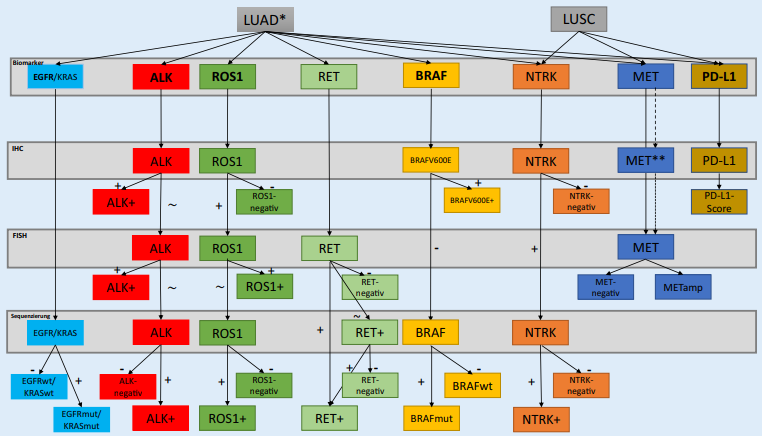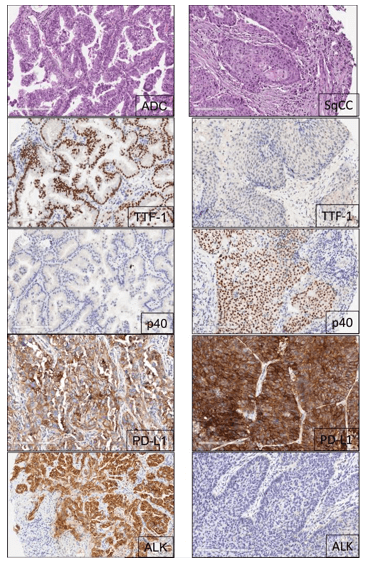Creative Bioarray provides a comprehensive FISH analysis solution to help customers solve gene analysis and expression level evaluation in a variety of lung cancer research. Our FISH analysis solution can be used for the analysis of high-risk biomarkers in lung cancer prognosis, the verification of transcriptome data (including mRNA and ncRNA), and the evaluation of cancer predictive markers. In addition, we also provide characteristic immuno-FISH technical services for multi-level analysis of related targets.
Research on Biomarkers in Lung Cancer
Lung cancer is the most common cause of cancer-related death worldwide, and the three main histological types of non-small cell lung cancer (NSCLC) include adenocarcinoma, squamous cell carcinoma, and large cell carcinoma. Different types of lung cancer have different genetic changes. The most frequently reported mutations in adenocarcinoma occur in the KRAS and EGFR genes, and the most frequently reported overexpression of EGFR in squamous cell carcinoma. The diagnosis of lung cancer is a challenge, which is closely related to the development of personalized treatment of lung cancer and the molecular and precise histological characteristics. Lung cancer is a very heterogeneous disease at the cellular and histological levels. Cellular and histological heterogeneity has been resolved, focusing on the diagnosis, pre-neoplastic lesions and cell origin, in an attempt to help better understand carcinogenesis. The heterogeneity of lung cancer has an impact on the understanding of pathogenesis, diagnosis, tissue selection for molecular diagnosis, and treatment decisions.
 Fig 1. Therapierelevante Biomarker: Darstellung der NSCLC-relevanten (NSCLC, nichtkleinzelliges Bronchialkarzinom) Biomarker und der Etappen der molekularen Aufarbeitung. (Hieggelke L, et al. 2020)
Fig 1. Therapierelevante Biomarker: Darstellung der NSCLC-relevanten (NSCLC, nichtkleinzelliges Bronchialkarzinom) Biomarker und der Etappen der molekularen Aufarbeitung. (Hieggelke L, et al. 2020)
FISH Service of Biomarker in Tumor Immune Microenvironment
Biopsy has always been of great significance for the classification, diagnosis and treatment of lung cancer. Cytogenetic methods such as FISH and IHC can be used to reflect tumor heterogeneity, because different types of lung cancer may come from different cell sources or differentiation pathways. The histology and cell heterogeneity analysis of lung cancer has been reflected by some cell markers, such as adenocarcinoma differentiation markers (such as CK7 and TTF1) and squamous differentiation markers (such as CK5/6 or other high molecular weight cytokeratins) .
The expression of many oncogenes in lung cancer is abnormal, such as EGFR, ALK, ROS1, and BRAF. In addition to the inherent heterogeneity of cancer cells, cells in the tumor microenvironment (TME) further promote the heterogeneity of tumors in a way that is external to cancer cells, which includes many immune cells. Therapies such as immune checkpoint inhibitors are becoming more popular. Many immune checkpoints and functional markers in TME can be used as targets for screening. Some sequencing data also reflects this view. Our RNA-FISH service can be used to verify the mutation sites found in the data. This work can assist in the development of potentially useful biomarkers.
 Fig 2. Representative examples of histology of lung adenocarcinoma (ADC) and squamous cell carcinoma (SqCC) histology and biomarker analysis using IHC. (Villalobos P, et al. 2017)
Fig 2. Representative examples of histology of lung adenocarcinoma (ADC) and squamous cell carcinoma (SqCC) histology and biomarker analysis using IHC. (Villalobos P, et al. 2017)
If you have RNA-FISH and immuno-FISH analysis requirements in lung cancer samples, please contact us for cooperation. We look forward to cooperating with you in the near future.
References
- Hieggelke L, Schultheis A M. Anwendungen der FISH in der Diagnostik von Lungenkarzinomen[J]. Der Pathologe, 2020: 1-7.
- Villalobos P, Wistuba I I. Lung cancer biomarkers[J]. Hematology/Oncology Clinics, 2017, 31(1): 13-29.


 Fig 1. Therapierelevante Biomarker: Darstellung der NSCLC-relevanten (NSCLC, nichtkleinzelliges Bronchialkarzinom) Biomarker und der Etappen der molekularen Aufarbeitung. (Hieggelke L, et al. 2020)
Fig 1. Therapierelevante Biomarker: Darstellung der NSCLC-relevanten (NSCLC, nichtkleinzelliges Bronchialkarzinom) Biomarker und der Etappen der molekularen Aufarbeitung. (Hieggelke L, et al. 2020) Fig 2. Representative examples of histology of lung adenocarcinoma (ADC) and squamous cell carcinoma (SqCC) histology and biomarker analysis using IHC. (Villalobos P, et al. 2017)
Fig 2. Representative examples of histology of lung adenocarcinoma (ADC) and squamous cell carcinoma (SqCC) histology and biomarker analysis using IHC. (Villalobos P, et al. 2017)


